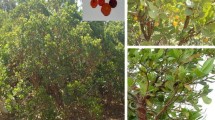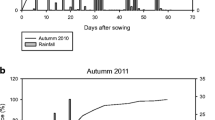Abstract
Over a period of 7 years the biology and phenotypic variability of Chusquea culeou were studied at 5 locations in cool temperate forests of southern Argentina. Excavated rhizomes had an average of 1.1 successful rhizome buds, and an average of 2.1 years elapsed between successive generations of rhizomes. Rhizome buds usually develop within the first four years after a rhizome forms. Height, volume and weight of a culm can be calculated from its diameter 1 m above the ground. Culm size, length of foliage leaf blades, and pattern of secondary branching differed among study sites. Dead culms were numerous and commonly remained erect for more than 7 years after dying. New culm shoots appear in spring and reach full size within a few months. Shoots can grow more than 9 cm/day. Less than half of the shoots survived a year; most were killed by moth larvae. Multiple primary branch buds emerge through the culm leaf sheaths in the second spring. The mean number of branch buds at mid-culm nodes varied between 34.8 and 81.5, and the mean number of primary branches was between 22.8 and 40.8. Number and length of branches, and number and length of foliage leaf blades at each node is related to the position of the node on a culm. Most branches grow about 3 cm and produce 1 to 3 foliage leaves annually. Foliage leaf blades generally live 2 years or more; few survive 6 years. Relative lengths of foliage leaf blades and their spacing along a branch permit recognition of annual cohorts.
Both gregarious and sporadic flowering have been reported, and every year a few isolated plants flower and die. Length of the life cycle is unknown. Seedlings require up to 15 years to produce culms of mature size. Foliage branches may live more than 23 years, and culms may survive 33 years. Extensive loss of new shoots to predation suggests that gregarious flowering may be driven by a need to escape parasitism. C. culeou clumps expand slowly. Average annual rate of increase of the number of live culms in a clump was 4.6%. Methods of seed dispersal are undocumented. A dense stand of Chusquea culeou had an estimated phytomass of 179 tons/hectare (dry weight), 28% of which was underground. Net annual production was about 16 t/ha dry weight.
Similar content being viewed by others
References
Art, H. W. & Marks, P. L. 1971. A summary table of biomass and net annual primary production in forest ecosystems of the world. In: Forest Biomass Studies, Sec. 25: Yield and Growth, 15th Int. Congr., Union Forest Res. Organ., Misc. Publ. 132, Life Sciences and Agriculture Experiment Station, Univ. Maine, Orono, pp. 3–32.
Boelcke, O. 1957. Communidades herbáceas del Norte de Patagonia y sus relaciones con la ganaderia. Rev. Invest. Agric. (B. Aires) 11 (1): 5–98 + 17 plates.
Clark, L. G. 1985. Three new species of Chusquea (Gramineae: Bambusoideae). Ann. Misso. Bot. Gard. 72: 864–873.
Clark, L. G. 1989. Systematics of Chusquea section Swallenochloa, section Verticillatae, section Serpentes, and section Longifoliae (Poaceae-Bambusoideae). Syst. Bot. Monogr., 27: 1–127.
DeAngelis, D. L., Gardner, R. H. & Shugart, H. H. 1981. Productivity of forest ecosystems studied during the IBP: the woodlands data set. In: Dynamics properties of forest ecosystems. (D. E. Reichle, ed.). Int. Biol. Programme 23, pp. 567–672. Cambridge Univ. Press, Cambridge.
Freier, F. 1941. Contribución al estudio de la anatomia foliar de las especies del género ‘Chusquea’ de la flora Argentina. Rev. Argent. Agron. 8: 364–379.
Gadgil, M. & Prasad, S. N. 1984. Ecological determinants of life history evolution of two Indian bamboo species. Biotropica 16: 161–172.
Gallopin, G. C. 1978. Estudio ecológico integrado de la cuenca del Rio Manso Superior (Río Negro, Argentina). I. Descripción general de la cuenca. An. Parques Nac. (B. Aires) 14: 161–230.
Garcia, D. R., Sourouille, A., Gallopin, G. C. & Montaña, C. 1978. Estudio ecológico integrado de la cuenca del Río Manso Superior (Rio Negro, Argentina). II. Tipos de vegetación. An. Parques Nac. (B. Aires) 14: 231–248.
Gunckel L., H., 1948. La floración de la quila y del colihue en la Araucania. Cien. Invest. (B. Aires) 4: 91–95.
Haverbeck M., R. F. 1983. Estudio del crecimiento, variación morfológica y reacción al corte de coligue (Chusquea culeou Desv.) en un bosque de coigue-tepa-mañio, en el predio San Pablo de Tregua, Panguipulli. Thesis, Univ. Austral, Valdivia, Chile.
Hosseus, C. K. 1915. Las cañas de bambú en las cordilleras del sud. Bol. Minist. Agric. (Rep. Argent.) 19: 195–208.
Janzen, D. H. 1976. Why bamboos wait so long to flower. Ann. Rev. Ecol. Syst. 7: 347–391.
Lebedeff, N. 1942. Informe preliminar sobre los estudios de los bosques en la reserva ‘Lanin’. Bol. Forestal correspondiente a los años 1938-1939-1940. Dir. Parques Nac., B. Aires, 221 pp.
Markgraf, V. 1983. Late and postglacial vegetational and climatic changes in subantarctic, temperate, and arid environments in Argentina. Palynology 7: 43–70.
McClure, F. A. 1966. The Bamboos. A Fresh Perspective. Harvard Univ. Press, Cambridge, Mass. xv + 347 pp.
Mermoz, M. & Martin, C. 1987. Mapa de vegetación del Parque y La Reserva Nacional Nahuel Huapi. Secretaria de Cienc. y Tec. de la Nacion, Delegacion Regional Patagonia, Argent. 22 pp.
Nicora, E. G. 1978. Flora Patagónica, Parte III Gramineae. Colece. Cientifica INTA, Tomo VIII, (M. N. Correa, ed.), B. Aires.
Numata, M. 1965. Ecology of bamboo forests in Japan. In: Adv. Front. Pl. Sci. 10: 89–119, New Delhi.
Parodi, L. R. 1941. Estudio, preliminar sobre el género ‘Chusquea’ en La Argentina. Rev. Argent. Agron. 8: 331–345.
Parodi, L. R. 1945. Sinopsis de las gramineas Chilenas del genero Chusquea. Rev. Univ. (Univ. Catolica Chile) 30: 61–71.
Patterson, B. D. 1992. A new genus and species of long-clawed mouse (Rodentia: Muridae) from temperate rainforests of Chile. Zool. J. Linn. Soc. 106: 127–145.
Pearson, O. P. 1983. Characteristics of a mammalian fauna from forests in Patagonia, southern Argentina. J. Mammal. 64: 476–492.
Pearson, O. P. & Pearson, A. K. 1982. Ecology and biogeography of the southern rainforests of Argentina. In: Mammalian Biology in South America. (M. A. Mares & Genoways, H. H., eds.). 6: 129–142. Spec Publ. Ser. Pymatuning Lab. Ecol., Univ. Pittsburgh, Pennsylvania.
Porterfield, W. M. 1933. The periodicity of bamboo culm structures. China J. 18: 357–371.
Ralph, C. J. 1985. Habitat association patterns of forest and steppe birds of northern Patagonia, Argentina. Condor 87: 471–483.
Veblen, T. T. 1982. Growth patterns of Chusquea bamboos in the understory of Chilean Nothofagus forests and their influence in forest dynamics. Bull. Torrey Bot. Club 109: 474–487.
Veblen, T. T., Schlegel, F. M. & Escobar, R. B. 1980. Drymatter production of two species of bamboo (Chusquea culeou and C. tenuiflora) in south-central Chile. J. Ecol. 68: 397–404.
Vuilleumier, F. 1968. Origin of frogs of Patagonian forests. Nature 219: 87–89.
Vuilleumier, F. 1985. Forest birds of Patagonia: ecological geography, speciation, endemism, and faunal history. In: Neotropical ornithology. (P. A. Buckley, M. S. Foster, E. S. Morton, R. S. Ridgley & F. G. Buckley, eds.). Ornith. Monogr. 36: 255–288. Am. Ornith. Union, Wash.
Ward, R. T. 1965. Beech (Nothofagus) forests in the Andes of southwestern Argentina. Am. Midl. Nat. 74: 50–56.
Author information
Authors and Affiliations
Rights and permissions
About this article
Cite this article
Pearson, A.K., Pearson, O.P. & Gomez, I.A. Biology of the bamboo Chusquea culeou (Poaceae: Bambusoideae) in southern Argentina. Vegetatio 111, 93–126 (1994). https://doi.org/10.1007/BF00040331
Accepted:
Issue Date:
DOI: https://doi.org/10.1007/BF00040331




